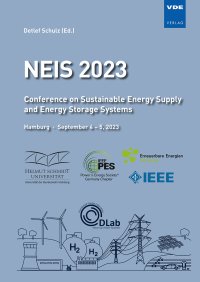Decarbonizing Heavy Industry by Using Green Electricity and Hydrogen – A Case Study of a Glass Production Site
Konferenz: NEIS 2023 - Conference on Sustainable Energy Supply and Energy Storage Systems
04.09.2023–05.09.2023 in Hamburg, Germany
Tagungsband: NEIS 2023
Seiten: 6Sprache: EnglischTyp: PDF
Autoren:
Brucksch, Jonas; van Ouwerkerk, Jonas; Bussar, Christian (Institute for Power Electronics and Electrical Drives (ISEA), RWTH Aachen University, Aachen, Germany & Institute for Power Generation and Storage Systems (PGS), RWTH Aachen University, Aachen, Germany & Juelich Aachen Research Alliance, JARA-Energy, Germany)
Sauer, Dirk Uwe (Institute for Power Electronics and Electrical Drives (ISEA), RWTH Aachen University, Aachen, Germany & Institute for Power Generation and Storage Systems (PGS), RWTH Aachen University, Aachen, Germany & Juelich Aachen Research Alliance, JARA-Energy, Germany & Forschungszentrum Jülich GmbH, Institute of Energy and Climate Research Helmholtz-Institute Münster: Ionics in Energy Storage (IEK-12)), Jülich, Germany)
Inhalt:
Decarbonizing the industrial sector, which currently emits around one-fifth of Germany's greenhouse gas emissions, is one of the central challenges in the transition to a net-zero energy system. The glass industry is an especially challenging case because of its high dependence on primary energy. The decarbonization of this sector requires the transition from using fossil fuels to renewable electricity sources and green hydrogen. Highly complex system structures and non-linear components make a detailed analysis challenging. This work presents a mixed-integer linear program, which includes a linearized model for the electrolyzer component and measurement data from an operating glass production site. With this, we present a cost analysis for the fuel-switching process incorporating renewable energy sources (RES), battery storages, and local hydrogen production for firing a hybrid melting furnace. The results indicate a cost increase in all future scenarios. Especially a fuel switch without using RES leads to 82 % higher costs compared to the conventional melting process with a new natural-gas fired furnace. Costs decrease significantly by generating renewable energy on the side or procuring it through power purchase agreements (PPAs). Further, we identify significant differences in the usage of the electrolyzer and hydrogen tank depending on the inclusion of renewable energy sources or PPAs to produce green hydrogen. Future research may include more detailed modeling of the hydrogen components as a central part of such an industrial complex and more variability in the PPA contracting.


